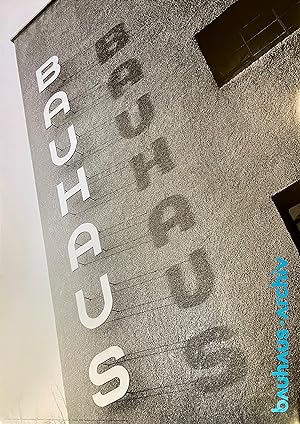Kunst, staatliches bauhaus (2 Ergebnisse)
FeedbackSuchfilter
Produktart
- Alle Product Types
- Bücher (98)
- Magazine & Zeitschriften (Keine weiteren Ergebnisse entsprechen dieser Verfeinerung)
- Comics (Keine weiteren Ergebnisse entsprechen dieser Verfeinerung)
- Noten (Keine weiteren Ergebnisse entsprechen dieser Verfeinerung)
- Kunst, Grafik & Poster (2)
- Fotografien (1)
- Karten (Keine weiteren Ergebnisse entsprechen dieser Verfeinerung)
- Manuskripte & Papierantiquitäten (Keine weiteren Ergebnisse entsprechen dieser Verfeinerung)
Zustand
- Alle
- Neu (Keine weiteren Ergebnisse entsprechen dieser Verfeinerung)
- Antiquarisch (2)
Einband
- alle Einbände
- Hardcover (Keine weiteren Ergebnisse entsprechen dieser Verfeinerung)
- Softcover (Keine weiteren Ergebnisse entsprechen dieser Verfeinerung)
Weitere Eigenschaften
- Erstausgabe (Keine weiteren Ergebnisse entsprechen dieser Verfeinerung)
- Signiert (Keine weiteren Ergebnisse entsprechen dieser Verfeinerung)
- Schutzumschlag (Keine weiteren Ergebnisse entsprechen dieser Verfeinerung)
- Angebotsfoto (2)
Sprache (1)
Preis
- Beliebiger Preis
- Weniger als EUR 20 (Keine weiteren Ergebnisse entsprechen dieser Verfeinerung)
- EUR 20 bis EUR 45 (Keine weiteren Ergebnisse entsprechen dieser Verfeinerung)
- Mehr als EUR 45
Gratisversand
- Kostenloser Versand nach USA (Keine weiteren Ergebnisse entsprechen dieser Verfeinerung)
Land des Verkäufers
Verkäuferbewertung
-
"BAUHAUS" lettering on bauhaus building - 59 x 83 cm POSTER
Verlag: Bauhaus Archiv gmbh, Berlin
Anbieter: °ART...on paper - 20th Century Art Books, Lugano, Schweiz
Verbandsmitglied: ILAB
Kunst / Grafik / Poster
EUR 131,03
Währung umrechnenEUR 25,00 für den Versand von Schweiz nach USAAnzahl: 1 verfügbar
In den WarenkorbNo Binding. Zustand: Very Good. Original poster with photo-reproduction of "bauhaus lettering on bauhaus building (ca. 1930). 59 x 83 cm, in very good condition. The Staatliches Bauhaus commonly known as the Bauhaus (German for 'building house'), was a German art school operational from 1919 to 1933 that combined crafts and the fine arts.[1] The school became famous for its approach to design, which attempted to unify individual artistic vision with the principles of mass production and emphasis on function. The Bauhaus was founded by architect Walter Gropius in Weimar. It was grounded in the idea of creating a Gesamtkunstwerk ("comprehensive artwork") in which all the arts would eventually be brought together. The Bauhaus style later became one of the most influential currents in modern design, modernist architecture, and architectural education.The Bauhaus movement had a profound influence upon subsequent developments in art, architecture, graphic design, interior design, industrial design, and typography. Staff at the Bauhaus included prominent artists such as Paul Klee, Wassily Kandinsky, and László Moholy-Nagy at various points. Bauhaus founder Walter Gropius (1883 1969) The school existed in three German cities Weimar, from 1919 to 1925; Dessau, from 1925 to 1932; and Berlin, from 1932 to 1933 under three different architect-directors: Walter Gropius from 1919 to 1928; Hannes Meyer from 1928 to 1930; and Ludwig Mies van der Rohe from 1930 until 1933, when the school was closed by its own leadership under pressure from the Nazi regime, having been painted as a centre of communist intellectualism. Although the school was closed, the staff continued to spread its idealistic precepts as they left Germany and emigrated all over the world. The changes of venue and leadership resulted in a constant shifting of focus, technique, instructors, and politics. For example, the pottery shop was discontinued when the school moved from Weimar to Dessau, even though it had been an important revenue source; when Mies van der Rohe took over the school in 1930, he transformed it into a private school and would not allow any supporters of Hannes Meyer to attend it.
-
PAUL BRAIG : BONHEUR DE FRANCE - 23 octobre-63 x 48 cm POSTER17 novembre 195830 Maitres Contemporains, Galerie des caves de la Tour Eiffel; 5 square Charles Dickens (Rue des eaux) - 1958,
Verlag: Mourlot imp. Paris, 1958
Anbieter: °ART...on paper - 20th Century Art Books, Lugano, Schweiz
Verbandsmitglied: ILAB
Kunst / Grafik / Poster
EUR 163,79
Währung umrechnenEUR 25,00 für den Versand von Schweiz nach USAAnzahl: 1 verfügbar
In den WarenkorbNo Binding. Zustand: Very Good. Gorgeous poster-lithograph by Paul Braig. 63 x 48 cm, in very good condition. Paul Braig was born in 1906. He was educated in Germany at the Staatliches Bauhaus, after which he moved to France, where he studied under Roger Bissière. Braig made many expressionistic paintings during his lifetime, but never quite rose to fame or success. He died in 1972, still an obscure name in French art history.



